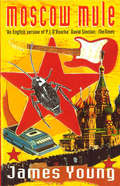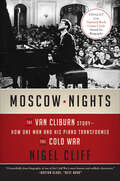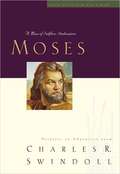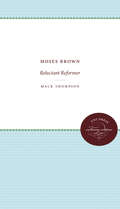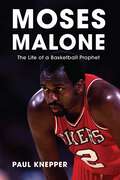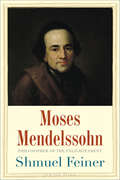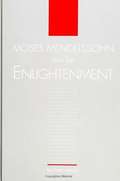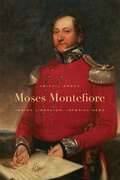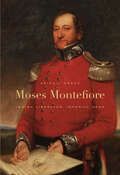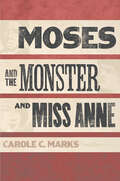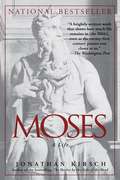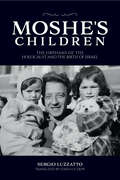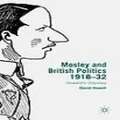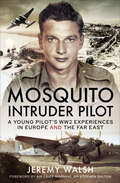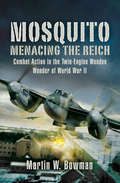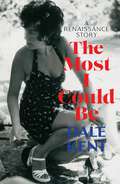- Table View
- List View
Moscow Mule
by James YoungA marvellously funny and sharply observed account of a journey to Russia by one of Britain's most talented young writers. Moscow - a labyrinth where the humans try to keep one step ahead of the roaches. Everyone on the move, some in search of the quick buck, and others just trying to survive. All dazzled by the neon glare of the western dream. The soviet monolith has broken down in tribalism, tribes who go to war not just on the streets but in overheated rooms, with drugs, vodka and Cindy Crawford carrier bags. James Young gives an unparalleled account of today's Moscow from the bottom side up. He takes us on a odyssey through this strange no man's land where East meets West, where the old certainties have gone, the KGB men wear Italian suits, the Mafia tycoonskis style themselves on the Godfather flicks and the rest are queuing to change dollars.
Moscow Nights: The Van Cliburn Story-How One Man and His Piano Transformed the Cold War
by Nigel Cliff“A rousing, well-researched biography” of the Texan piano prodigy who crossed the Iron Curtain at the height of the Cold War (Kirkus, starred review). A National Book Critic’s Circle FinalistIn 1958, an unheralded young pianist named Van Cliburn traveled to Moscow to compete in the First International Tchaikovsky Competition. The Soviets had no intention of bestowing their coveted prize on an unknown American; a Russian pianist had already been chosen to win. Yet when the gangly Texan with the shy grin began to play, he instantly captivated an entire nation.The Soviet people were charmed by Van Cliburn’s extraordinary talent, but it was his palpable love for the music that earned their devotion; for many, he played more like a Russian than their own musicians. As enraptured crowds mobbed Cliburn’s performances, pressure mounted to award him the competition prize. “Is he the best?” Soviet Premier Nikita Khrushchev demanded of the judges. “In that case . . . give him the prize!”Adored by millions in the USSR, Cliburn returned to a hero’s welcome in the USA and became, for a time, an ambassador of hope. In this thrilling, impeccably researched account, Nigel Cliff recreates the drama and tension of the Cold War era, and brings into focus the gifted musician whose music would temporarily bridge the divide between two dangerously hostile powers.
Moses Brown: Reluctant Reformer (Published by the Omohundro Institute of Early American History and Culture and the University of North Carolina Press)
by Mack ThompsonMoses Brown carried on a wide range of business activities, seeking profit as capital for humanitarian purposes. He became a reluctant participant and eventually a leader in many reform movements--crusades against slavery and war; efforts to provide education for the underprivileged, orphans, and Afro-Americans; and programs of urban redevelopment and public health.Originally published in 1962.A UNC Press Enduring Edition -- UNC Press Enduring Editions use the latest in digital technology to make available again books from our distinguished backlist that were previously out of print. These editions are published unaltered from the original, and are presented in affordable paperback formats, bringing readers both historical and cultural value.
Moses Jacob Ezekiel: Jewish, Confederate, Expatriate Sculptor
by Samantha BaskindHow is it that the prolific nineteenth-century sculptor Moses Jacob Ezekiel is largely forgotten today? Ezekiel was the first renowned Jewish American artist and one of the most popular artist-celebrities of his day. In terms of drama, his life story rivals Alexander Hamilton’s. Ezekiel fought for the Confederacy at the Battle of New Market as a teenager and was friends with Robert E. Lee. After the war, he established himself as an artist in Rome, where he was honored by European royalty and enjoyed friendships with the likes of Franz Liszt, Queen Margherita, and Kaiser Wilhelm II. Ezekiel created well over one hundred sculptures, but his hotly contested Confederate works have since obscured his other major accomplishments.Drawing on a wealth of primary sources, Moses Jacob Ezekiel resurrects this complicated artist’s life and work and presents the fascinating details of how his sculptures were commissioned and made. Samantha Baskind shows how Ezekiel’s sculptures shed light on a range of issues, including the modernization of American Jewry, radical changes in the art world concerning style and patronage, and Civil War commemoration. The conflicting allegiances that motivated Ezekiel’s statues—his conservative Confederate leanings alongside his liberal views on peace, Judaism, and religious liberty—make him an intriguing lens through which to understand nineteenth-century transatlantic culture and history.This compelling book provides a complete picture of Ezekiel’s oeuvre and his renowned home studio, which drew international visitors. It will appeal to readers interested in art history, Jewish studies, Civil War studies, American studies, and public monuments.
Moses Malone: The Life of a Basketball Prophet
by Paul KnepperMoses Malone overcame abject poverty in segregated Petersburg, Virginia, to become the first modern-day basketball player to jump directly from high school to the pros, paving a path for future stars such as Kobe Bryant, Kevin Garnett, and LeBron James to follow. Moses Malone: The Life of a Basketball Prophet tells the story of Malone&’s ascent in the early 1970s to becoming the premier player in the world for a five-year period. The young Malone prophesied his improbable rise and succeeded where others later failed because of his strength of character and unparalleled work ethic. Malone dominated his years in the NBA with a relentless determination that made him the greatest offensive rebounder in basketball history—a record he holds to this day. From 1979 to 1983 he won three of the NBA&’s Most Valuable Player awards and with Julius Erving helped to deliver the Philadelphia 76ers to the NBA championship in 1983. He remains one of just nine players to win the NBA MVP award three or more times. In many ways Malone was an anti-superstar. He lacked a signature move, displayed almost no ego, and shunned the spotlight to the detriment of his commercial appeal. Shy by nature and self-conscious about a speech impediment, Moses kept his distance from the media, some of whom mistook his reticence for stupidity. A man of few words, he possessed a magnetism rooted in humility, authenticity, and passion. Moses was a giver, equally generous in assisting a friend as he was mentoring younger players, including Charles Barkley and Hakeem Olajuwon. While his contemporaries preened for the cameras, Moses remained the &“lunch pail superstar,&” a quiet and humble teammate who expressed himself through his tireless effort on the court and compassion off it.
Moses Mendelssohn Sage of Modernity
by Shmuel FeinerThe "German Socrates," Moses Mendelssohn (1729-1786) was the most influential Jewish thinker of the eighteenth and nineteenth centuries. A Berlin celebrity and a major figure in the Enlightenment, revered by Immanuel Kant, Mendelssohn suffered the indignities common to Jews of his time while formulating the philosophical foundations of a modern Judaism suited for a new age. His most influential books included the groundbreakingJerusalemand a translation of the Bible into German that paved the way for generations of Jews to master the language of the larger culture. Feiner's book is the first that offers a full, human portrait of this fascinating man--uncommonly modest, acutely aware of his task as an intellectual pioneer, shrewd, traditionally Jewish, yet thoroughly conversant with the world around him--providing a vivid sense of Mendelssohn's daily life as well as of his philosophical endeavors. Feiner, a leading scholar of Jewish intellectual history, examines Mendelssohn as father and husband, as a friend (Mendelssohn's long-standing friendship with the German dramatist Gotthold Ephraim Lessing was seen as a model for Jews and non-Jews worldwide), as a tireless advocate for his people, and as an equally indefatigable spokesman for the paramount importance of intellectual independence.
Moses Mendelssohn and the Enlightenment
by Allan ArkushArkush (Judaic studies, State U. of New York at Binghamton) discusses the relationship between Mendelssohn's philosophical rationalism and his Judaism, and places his thought within the context of the Leibnizian-Wolffian school, the writings of Kant, and within the tradition of Jewish rationalism. Arkush questions the extent to which Mendelssohn succeeded in reconciling the philosophy of the Enlightenment with his adherence to Judaism.
Moses Montefiore
by Abigail GreenHumanitarian, philanthropist, and campaigner for Jewish emancipation on a grand scale, Sir Moses Montefiore (1784-1885) was the preeminent Jewish figure of the nineteenth century-and one of the first truly global celebrities. His story, told here in full for the first time, is a remarkable and illuminating tale of diplomacy and adventure. Abigail Green's sweeping biography follows Montefiore through the realms of court and ghetto, tsar and sultan, synagogue and stock exchange. Interweaving the public triumph of Montefiore's foreign missions with the private tragedy of his childless marriage, this book brings the diversity of nineteenth-century Jewry brilliantly to life-from London to Jerusalem, Rome to St. Petersburg, Morocco to Istanbul. Here we see the origins of Zionism and the rise of international Jewish consciousness, the faltering birth of international human rights, and the making of the modern Middle East. With the globalization and mobilization of religious identities now at the top of the political agenda, Montefiore's life story is relevant as never before. Mining materials from eleven countries in nine languages, Green's masterly biography bridges the East-West divide in modern Jewish history, presenting the transformation of Jewish life in Europe, the Middle East, and the New World as part of a single global phenomenon. As it reestablishes Montefiore's status as a major historical player, it also restores a significant chapter to the history of our modern world.
Moses Montefiore: Jewish Liberator, Imperial Hero
by Abigail Green“A rich gift to history—and not just Jewish history—for its account not just of what Moses Montefiore did or did not do, but also of what he was.” —New RepublicHumanitarian, philanthropist, and campaigner for Jewish emancipation on a grand scale, Sir Moses Montefiore (1784–1885) was the preeminent Jewish figure of the nineteenth century. His story, told here in full for the first time, is a remarkable and illuminating tale of diplomacy and adventure. Abigail Green’s sweeping biography follows Montefiore through the realms of court and ghetto, tsar and sultan, synagogue and stock exchange.Interweaving the public triumph of Montefiore’s foreign missions with the private tragedy of his childless marriage, this book brings the diversity of nineteenth-century Jewry brilliantly to life. Here we see the origins of Zionism and the rise of international Jewish consciousness, the faltering birth of international human rights, and the making of the modern Middle East. Mining materials from eleven countries in nine languages, Green’s masterly biography bridges the East-West divide in modern Jewish history, presenting the transformation of Jewish life in Europe, the Middle East, and the New World as part of a single global phenomenon. As it reestablishes Montefiore’s status as a major historical player, it also restores a significant chapter to the history of our modern world.“A masterpiece of scholarship and historical imagination.” —Niall Ferguson, New York Times bestselling author of The Square and the Tower“Entertaining.” —The Economist“A perceptive, solidly researched biography with expressive period illustrations attesting to Montefiore's global celebrity.” —Publishers Weekly (starred review)“Deeply impressive. . . . One of the essential works on modern Jewish history.” —Tablet Magazine“Fair and illuminating.” —The Wall Street Journal
Moses Was a Basket Case: Hilarious True Stories to Encourage and Inspire
by James A. JasperHilarious true stories to encourage and inspire A number of very funny and inspiring stories from a DJ, standup comedian, and inspirational speaker. James "J.J." Jasper is a Christian radio DJ who thoroughly enjoys telling the stories of his life.
Moses and the Monster and Miss Anne
by Carole C. MarksThis engaging history presents the extraordinary lives of Patty Cannon, Anna Ella Carroll, and Harriet Tubman, three "dangerous" women who grew up in early-nineteenth-century Maryland and were vigorously enmeshed in the social and political maelstrom of antebellum America. The "monstrous" Patty Cannon was a reputed thief, murderer, and leader of a ruthless gang who kidnapped free blacks and sold them back into slavery, whereas Miss Anna Ella Carroll, a relatively genteel unmarried slaveholder, foisted herself into state and national politics by exerting influence on legislators and conspiring with Governor Thomas Holliday Hicks to keep Maryland in the Union when many state legislators clamored to join the Confederacy. And, of course, Harriet Tubman--slave rescuer, abolitionist, and later women's suffragist--was both hailed as "the Moses of her people" and hunted as an outlaw with a price on her head worth at least ten thousand dollars. All three women lived for a time in close proximity on the Eastern Shore of Maryland, an isolated region that thrived on tobacco and then lost it, procured slaves and then lost them, and produced strong-minded women and then condemned them. Though they never actually met, and their backgrounds and beliefs differed drastically, these women's lives converged through their active experiences of the conflict over slavery in Maryland and beyond, the uncertainties of economic transformation, the struggles in the legal foundation of slavery and, most of all, the growing dispute in gender relations in America. Throughout this book, Carole C. Marks gleans historical fact and sociological insight from the persistent myths and exaggerations that color the women's legacies, and she investigates the common roots and motivations of three remarkable figures who bucked the era's expectations for women. She also considers how each woman's public identity reflected changing ideas of domesticity and the public sphere, spirituality, and legal rights and limitations. Cannon, Carroll, and Tubman, each in her own way, passionately fought for the future of Maryland and the United States, and from these unique vantage points, Moses and the Monster and Miss Anne portrays the intersecting and conflicting forces of race, economics, and gender that threatened to rend a nation apart.
Moses: A Human Life (Jewish Lives)
by Avivah Gottlieb ZornbergAn unprecedented portrait of Moses's inner world and perplexing character, by a distinguished biblical scholar No figure looms larger in Jewish culture than Moses, and few have stories more enigmatic. Avivah Gottlieb Zornberg, acclaimed for her many books on Jewish thought, turns her attention to Moses in this remarkably rich, evocative book. Drawing on a broad range of sources--literary as well as psychoanalytic, a wealth of classical Jewish texts alongside George Eliot, W. G. Sebald, and Werner Herzog--Zornberg offers a vivid and original portrait of the biblical Moses. Moses's vexing personality, his uncertain origins, and his turbulent relations with his own people are acutely explored by Zornberg, who sees this story, told and retold, as crucial not only to the biblical past but also to the future of Jewish history.
Moses: A Life
by Jonathan KirschLawgiver and liberator. Seer and prophet. The only human permitted to converse with God "face-to-face." Moses is the most commanding presence in the Old Testament. Yet as Jonathan Kirsch shows in this brilliant, stunningly original volume, Moses was also an enigmatic and mysterious figure--at once a good shepherd and a ruthless warrior, a spiritual leader and a magician, a lawgiver who broke his own laws, God's chosen friend and hounded victim. Now, in Moses: A Life, Kirsch accomplishes the wondrous feat of revealing the real Moses, a strikingly modern figure who steps out from behind the facade of Sunday school lessons and movie matinees.Drawing on the biblical text and a treasury of both scholarship and storytelling, Kirsch examines all that is known and all that has been imagined of Moses. In these vivid pages, we see the marvels and mysteries of Moses's life in a new light--his rescue in infancy and adoption by an Egyptian princess; his reluctant assumption of the role of liberator; his struggles to wrest his people from the pharaoh's dominion; his desperate vigil on Mount Sinai. Here too is the darker, more ominous Moses--the sorcerer, the husband of a pagan woman, the military commander who cold-bloodedly ordered the slaying of innocent people; the beloved of God whom God sought twice to murder.Jonathan Kirsch brings both prodigious knowledge and a keen imagination to one of the most compelling stories of the Bible, and the results are fascinating. A figure of mystery, passion, and contradiction, Moses emerges from this book very much a hero for our time.From the Hardcover edition.
Moses: Encountering God (Fisherman Bible Studyguide Series)
by Greg AsimakoupoulosMoses was a prince, an exiled shepherd, and a flawed reluctant leader of God's people. Readers will discover for themselves more about Moses and the miracle-working God whom he served.From the Trade Paperback edition.
Moses: The Epic Story of His Rebellion in the Court of Egypt
by Howard FastThe epic life story of Moses, from orphan child to leader of the Israelites, from the New York Times–bestselling author of Spartacus. In Moses, Fast breathes new life into the legendary story of the infant found among the reeds of the Nile. From Moses&’s adoption into the home of Pharaoh Ramses II, to his upbringing in Egypt&’s royal court, to his controversial support of monotheism and eventual leadership of a nation, Moses is a stunning look at the life of one of world history&’s most celebrated men. This ebook features an illustrated biography of Howard Fast including rare photos from the author&’s estate.
Moses: When Harriet Tubman Led Her People to Freedom
by Carole Boston Weatherford Kadir Nelson2007 Caldecott Honor book<P><P> I SET THE NORTH STAR IN THE HEAVENS AND I MEAN FOR YOU TO BE FREE . . .<P> Born into slavery, Harriet Tubman hears these words from God one summer night and decides to leave her husband and family behind and escape. Taking with her only her faith, she must creep through the woods with hounds at her feet, sleep for days in a potato hole, and trust people who could have easily turned her in.<P> But she was never alone.<P> In lyrical text, Carole Boston Weatherford describes Tubman's spiritual journey as she hears the voice of God guiding her north to freedom on that very first trip to escape the brutal practice of forced servitude. Tubman would make nineteen subsequent trips back south, never being caught, but none as profound as this first one. Courageous, compassionate, and deeply religious, Harriet Tubman, with her bravery and relentless pursuit of freedom, is a testament to the resilience of the human spirit.<P>Winner of the Coretta Scott King Medal
Moshe Dayan
by Mordechai Bar-OnInstantly recognizable with his iconic eye patch, Moshe Dayan (1915–1981) was one of Israel's most charismatic—and controversial—personalities. As a youth he earned the reputation of a fearless warrior, and in later years as a leading military tactician, admired by peers and enemies alike. As chief of staff during the 1956 Sinai Campaign and as minister of defense during the 1967 Six Day War, Dayan led the Israel Defense Forces to stunning military victories. But in the aftermath of the bungled 1973 Yom Kippur War, he shared the blame for operational mistakes and retired from the government. He later proved himself a principled and talented diplomat, playing an integral role in peace negotiations with Egypt. In this memorable biography, Mordechai Bar-On, Dayan's IDF bureau chief, offers an intimate view of Dayan's private life, public career, and political controversies, set against an original analysis of Israel's political environment from pre-Mandate Palestine through the early 1980s. Drawing on a wealth of Israeli archives, accounts by Dayan and members of his circle, and firsthand experiences, Bar-On reveals Dayan as a man unwavering in his devotion to Zionism and the Land of Israel. Moshe Dayanmakes a unique contribution to the history of Israel and the complexities of the Arab-Israeli conflict.
Moshe's Children: The Orphans of the Holocaust and the Birth of Israel (Studies in Antisemitism)
by Sergio LuzzattoMoshe's Children presents the inspiring story of Moshe Zeiri, a Jewish carpenter responsible for rescuing hundreds of Jewish refugee children who had survived the Final Solution. During the liberation of Italy, Zeiri, a volunteer in the British Army in Italy, assumed responsibility for and vowed to help around seven hundred Polish, Hungarian, Russian, and Romanian children. Although these orphans of the Shoah had been deprived of a family, a home, and a language and were irreparably robbed of their past, they were able to rebuild their lives through Zeiri's efforts as he founded the largest Jewish orphanage in postwar Europe in Selvino, Italy, where he began to rehabilitate the orphans and to teach them how to become citizens of the new nation of Israel.Moshe's Children also explores Zeiri's own story from birth in a shtetl to his upbringing and Zionist education, his journey to the Land of Israel, and his work there before the war. With narrative verve and scholarly acumen, Sergio Luzzatto brilliantly tells the gripping stories of these orphans of the Holocaust and the good man who helped point them to a real future.
Mosley and British Politics 1918–32
by David HowellOswald Mosley has been reviled as a fascist and lamented as the lost leader of both Conservative and Labour Parties. Concerned to articulate the demands of the war generation and to pursue an agenda for economic and political modernization his ultimate rejection of existing institutions and practices led him to fascism.
Mosquito Intruder Pilot: A Young Pilot’s WW2 Experiences in Europe and the Far East
by Jeremy WalshBen Walsh lied about his age to join the RAF, determined to play his part in the Second World War. He volunteered to be an intruder pilot, flying low level operations in the dark. Initially flying ops in Douglas Boston Intruder IIs, he then converted to the legendary de Havilland Mosquito FB VI. Ben flew ops for three years, starting in the skies over with Europe with 418 (RCAF) Squadron, then ferrying one of the first Mosquito FB VIs to India before flying in the Burma campaign with 27 Squadron (under Wing Commander Nicolson VC) and finally with 45 Squadron. The Mosquito developed problems in the severe climate it encountered in the Far East which resulted in the aircraft being temporarily grounded in November 1944. This saw Ben undertaking thirteen operational sorties in venerable Tiger Moths in the Arakan. Although Ben survived belly landings, crashes, enemy fire and engine failures, the strain of combat operations took its toll on the still-young pilot. He and his navigator asked to be removed from operations, but their request was denied, both being threatened with court martial. By the end of the war when still only 21 years old, Ben was suffering from a nervous condition known as ‘the twitch’. His confidence and health were restored by the young woman who had been his pen friend through the war, who became his wife and the mother of the man who has compiled this dramatic and moving story – Jeremy Walsh. Throughout the war, Ben maintained a ‘Roll of honor’ in his photograph album, memorializing his friends and colleagues who lost their lives. That album forms the backdrop to this important biography, which is based on Ben’s own recollections, his logbook and the notes he kept through the war. Mosquito Intruder Pilot is Ben’s story.
Mosquito Night Intruder Ace: Wing Commander Bertie Rex O’Bryen Hoare DFC & Bar, DSO & Bar
by Danny BurtBertie Rex O’Bryen Hoare was born on 6 June 1912. Having been educated at Harrow and Wye Agricultural College, ‘Sammy’, as he was often known to friends and family, entered the RAF on a short-service commission in 1936. In October 1938, while piloting a Fairy Battle Bertie sustained a serious injury from a piece of loose piece of aircraft cowling. This incident resulted in him being totally blinded in one eye. Though he was initially grounded, his determination to return to the air never diminished. The outbreak of war in September 1939, saw his wish be granted when Bertie was given permission to return to operational flying duties. Bertie was posted to 23 Squadron, which was flying Blenheims at the time. The squadron then converted to Havocs, the crews being tasked with undertaking out nighttime operations over Occupied Europe. Despite his restricted night vision and depth perception, Bertie went on to became one of the RAF’s leading advocates in the art of what was known as ‘intruder operations’. In the months and years that followed, Bertie served in, and then commanded, a number of RAF squadrons. By the time the war in Europe came to an end, he was the Station Commander at RAF Little Snoring in Norfolk – which, at the time, was home to de Havilland Mosquitos undertaking intruder operations. Bertie opted to remain in the RAF after the war, this time being posted to 84 Squadron. However, his luck finally ran out on 26 March 1947, when the Mosquito he was ferrying to Australia crashed off its northern coast. Reported missing at the time, Danny Burt reveals the full circumstances of this tragic incident. This is the biography of one of the RAF’s greatest characters of the Second World War. With his ‘epic’ over-sized mustache, Bertie Hoare was a pilot who, with the end of the fighting, had risen to the rank of Group Captain, been awarded the Distinguished Service Order and Bar, the Distinguished Flying Cross and Bar, and been Mentioned in Despatches. Bertie ended the war having flown over 100 combat sorties.
Mosquito: Combat Action in the Twin-engine Wooden Wonder of World War II
by Martin W. BowmanOn 15 November it came suddenly out of nowhere inches above the hangars with a crackling thunderclap of twin Merlins. As we watched, bewitched, it was flung about the sky in a beyond belief display for a bomber that could out perform any fighter. Well-bred whisper of a touch down, a door opened and down the ladder came suede shoes, yellow socks and the rest of Geoffrey de Havilland.The memories of Sergeant (later Flight Lieutenant DFC) Mike Carreck who was an observer with 105 Squadron when he first laid eyes on the new de Havilland Mosquito. This was an aircraft that would prove itself to be one of the most versatile and revered aircraft to fly with the RAF in World War II.This book is full of firsthand accounts from the crews that flew the Mossie in its roles as a bomber, long-range reconnaissance and low-level strike aircraft. The author has gathered together many of the most exciting operational reports that cover the period from the types introduction until the end of World War II. The text is interwoven with the background history of the personnel and squadrons, the purpose of the operations undertaken and their often devastating results.
Most Honorable Son: A Forgotten Hero's Fight Against Fascism and Hate During World War II
by Gregg JonesForeword by Naomi Ostwald Kawamura of Densho Introduction by William Fujioka of JANM Afterword by Jonathan Eig The first comprehensive biography of unjustly forgotten Japanese American war hero Ben Kuroki, who fought the Axis powers during World War II and battled racism, injustice, and prejudice on the home front. WINNER OF THE NEBRASKA BOOK AWARD Ben Kuroki was a twenty-four-year-old Japanese American farm boy whose heritage was never a problem in remote Nebraska—until Pearl Harbor. Among the millions of Americans who flocked to military stations to enlist, Ben wanted to avenge the attack, reclaim his family honor, and prove his patriotism. But as anti-Japanese sentiment soared, Ben had to fight to be allowed to fight for America. And fight he did. As a gunner on Army Air Forces bombers, Ben flew fifty-eight missions spanning three combat theaters: Europe, North Africa, and the Pacific, including the climactic B-29 firebombing campaign against Japan that culminated with the atomic bombing of Hiroshima and Nagasaki. He flew some of the war&’s boldest and bloodiest air missions and lived to tell about it. In between his tours in Europe and the Pacific, he challenged FDR&’s shameful incarceration of more than one hundred thousand people of Japanese ancestry in America, and he would be credited by some with setting in motion the debate that reversed a grave national dishonor. In the euphoric wake of America&’s victory, the decorated war hero used his national platform to carry out what he called his &“fifty-ninth mission,&” urging his fellow Americans to do more to eliminate bigotry and racism at home. Told in full for the first time, and long overdue, Ben&’s extraordinary story is a quintessentially American one of patriotism, principle, perseverance, and courage. It&’s about being in the vanguard of history, the bonding of a band of brothers united in a just cause, a timeless and unflinching account of racial bigotry, and one man&’s transcendent sense of belonging—in war, in peace, abroad, and at home.
Most I Could Be: A Renaissance Story
by Dale Kent'Of all the exhilarating slogans that galvanised women in the 1970s, determined to change ourselves and the world, the one that really inspired me was: 'Be the most that you can!' Even as a small girl, I was eager to be the most I possibly could. This desire drove my life.' Raised in an aspirational Australian working-class family of Christian Scientists, in the 1960s Dale Kent embarked on a lifelong struggle to fulfil the desire of many women of her generation - to be the most she could be. Despite discrimination and self-doubt, she escaped her controlling family and established an international career as a historian of the Florentine Renaissance. But she failed to liberate herself from the crippling views of women, love and sex she had internalised in childhood. Craving independence and sexual fulfilment, Kent left her child with her husband and started afresh in the United States on an academic road trip that took in Berkeley, Harvard, Princeton and the National Gallery of Art. Her story, both poignant and darkly comical, traces a counterpoint between increasing professional success, a desperate search for a sexual soulmate and a way back to her daughter.
